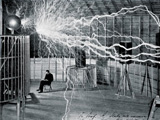|
|
TODAY.AZ / Weird / Interesting
Can wireless electricity kill people?
29 September 2011 [14:08] - TODAY.AZ
 Probably not. Even when it’s nipping at our toes, wireless electricity is pretty safe. In 1899, Serbian engineer Nikola Tesla built a 142-foot-tall, 12-million-volt electric coil in Colorado Springs and transmitted electricity wirelessly across 25 miles, illuminating 200 lamps with the charge. After he flipped the switch, flashes of lightning leaped from the coil, but no one was harmed.
Probably not. Even when it’s nipping at our toes, wireless electricity is pretty safe. In 1899, Serbian engineer Nikola Tesla built a 142-foot-tall, 12-million-volt electric coil in Colorado Springs and transmitted electricity wirelessly across 25 miles, illuminating 200 lamps with the charge. After he flipped the switch, flashes of lightning leaped from the coil, but no one was harmed.Tesla’s experiment proved that the Earth itself could be used to conduct electricity, no wires necessary. He also experimented with electromagnetic induction, a phenomenon discovered 70 years before Tesla’s experiments by the English scientist Michael Faraday. In electromagnetic induction, an oscillating magnetic field around an electromagnet produces a current in a nearby conductor—in effect, the current jumps the gap. While it is airborne, electric energy exists as a magnetic field. Magnetic induction is used today in the contact plates on electric toothbrushes, transmitting a charge from the plastic-wrapped charging station to the battery inside the brush.
In 2006, Marin Soljacic, a physics professor at the Massachusetts Institute of Technology, sent wireless electricity across a room to light a 60-watt bulb. Soljacic used electromagnetic induction, but with a twist. By tuning the sending and receiving coils in his electromagnetic field to resonate at the same frequency and engage only at that frequency (the way glass will shatter when struck by sound waves of just the right pitch), the current is focused and bypasses everything else, humans included. Resonant coupling, as Soljacic’s process is known, is far more efficient than Tesla’s attempts, and safer too.
Soljacic has a company called WiTricity, and he can now send 3,000 watts across a room—or a garage, since 3,000 watts can charge an electric car.
/Popular Science/
URL: http://www.today.az/news/interesting/95398.html
 Print version
Print version
Views: 1267
Connect with us. Get latest news and updates.
See Also
- 19 February 2025 [22:20]
Visa and Mastercard can return to Russia, but with restrictions - 05 February 2025 [19:41]
Japan plans to negotiate with Trump to increase LNG imports from United States - 23 January 2025 [23:20]
Dubai once again named cleanest city in the world - 06 December 2024 [22:20]
Are scented candles harmful to health? - 23 November 2024 [14:11]
Magnitude 4.5 earthquake hits Azerbaijan's Lachin - 20 November 2024 [23:30]
Launch vehicle with prototype of Starship made its sixth test flight - 27 October 2024 [09:00]
Fuel prices expected to rise in Sweden - 24 October 2024 [19:14]
Turkiye strikes terror targets in Iraq and Syria - 23 October 2024 [23:46]
Kazakhstan supplied almost entire volume of oil planned for 2024 to Germany in 9 months - 23 October 2024 [22:17]
Taiwan reported passage of Chinese Navy aircraft carrier near island
Most Popular
 Baku’s outreach to Brazil and Peru: economic synergy meets diplomatic leverage
Baku’s outreach to Brazil and Peru: economic synergy meets diplomatic leverage
 Putin’s double-headed eagle flies toward ruin
Putin’s double-headed eagle flies toward ruin
 Africa applauds Azerbaijan’s diplomatic efforts in climate and peace
Africa applauds Azerbaijan’s diplomatic efforts in climate and peace
 Azerbaijan, Hungary hold business forum in Budapest
Azerbaijan, Hungary hold business forum in Budapest
 Azerbaijan Media Delegation attends Global South Forum in China
Azerbaijan Media Delegation attends Global South Forum in China
 Poland urges citizens to leave Belarus immediately
Poland urges citizens to leave Belarus immediately
 Azerbaijani boxer advances at world championship in Liverpool
Azerbaijani boxer advances at world championship in Liverpool
